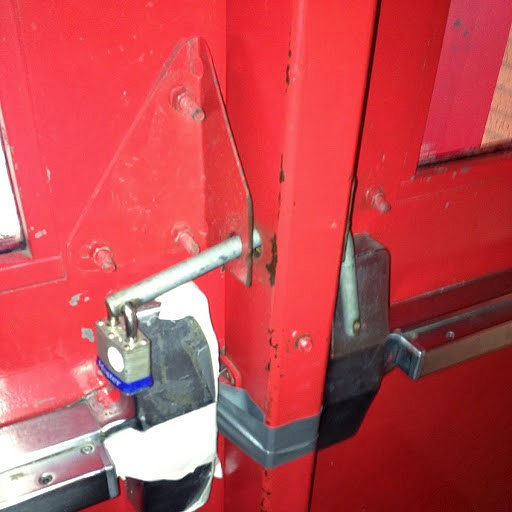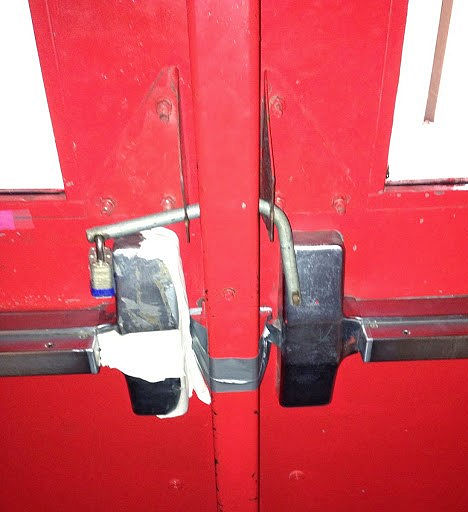Imagine that you were in an occupied high school gym and practice facility, and aaaaaaalllllll of the egress doors except the main entrance were locked with this method (and then scroll down):
In this exercise, the school is a potential customer for you. Your first step is to talk to the school administrators…maybe they don’t realize the code requirements and potential consequences of security devices that don’t allow free egress. But the administrators tell you that they have to lock the doors this way to prevent access from the outside. Their plan is for teachers and coaches to run to all of the doors and unlock them if there is an emergency (all staff members have keys to the padlocks). You give them a price to solve the problem with code-compliant hardware, but they say that it’s not in the budget this year.
You go back to the shop, worrying about the safety of the kids and the other occupants of the gym. You might get the fairly sizeable contract to replace the existing hardware in the future, but you can’t stop thinking about the “what-ifs.” So you hesitantly call the local fire marshal, who says that their office is aware of the situation at the school, but that the school needs a way to keep the doors secured (WHAT?). It appears that the local fire marshal is ok with the plan for teachers to run around and unlock the doors in an emergency.
When I see a problem in the field, it’s not uncommon for the building owner to respond that the fire marshal just visited, and didn’t object. I think there are a lot of potential reasons for this. Maybe the fire marshal didn’t notice the problem, or is not intimately familiar with the codes that address doors and hardware. Doors are complicated – especially doors with electrified hardware. Sometimes there are also political reasons for lack of enforcement.
So you go home, still worrying. What now? The school has a plan, and the local fire marshal accepts it. You don’t want to ruin your relationship with the facility, or jeopardize a future sale, but you know in your heart of hearts that it’s not a safe situation. You hunt down the contact info for the state fire marshal, and reluctantly get their office involved. Two days later, the school gets a visit from the SFM, and the padlocks and bars are removed.
WWYD?
Kudos to Randy Almand of Action Lock Doc for doing the right thing – and for sending me the photos!
~~~
If you’ll be at Autodesk University, stop by booth A345 and visit Allegion to see live demonstrations of Overtur. We’ll also be highlighting our recent enhancements and celebrating Overtur’s one year anniversary at an open house from 3:30 to 5:00 pm in Casanova Room 505/507. Come and see us!
You need to login or register to bookmark/favorite this content.







It’s worth risking the sale to keep kids safe. I just think worst case scenario: Pep Rally in the gym, active shooter stands in front of the main entrance–it’s like fish in a barrel. I want to know why the local marshal thought that was okay. The jimmy rigging is not new, and is at least a couple years old. They could have replaced one set a quarter with exit only trim and solved the whole problem. Those exit devices need to be replaced anyway–they’re falling apart.
My position does not fit the exercise but I hope that you don’t mind my two cents worth.
As a staff locksmith with a school board:
1/ That would not be allowed in our district if for no other reason than Liability.
2/ If I saw that I would not be speaking to any administrators until after I had cut off the locks, removed the mounting brackets and plugged the hole though the mullion with a sex bolt. Then I would seek out the Principal and tell him/her why the devices were removed.
3/ If I was told to install such a device my retirement papers would be filed immediately.
(I need an excuse!)
Fortunately our local Fire Marshal’s Office stick quite close to the book.
In the one instance where we installed some delayed egress panic bars on a high special needs facility it required approval by the Building Inspector, the Fire Marshal and had to be registered on the School’s title. As well, the bars were hooked up to the fire alarm system and the official fire plan was amended.
Our administration saw how serious (and expensive) the process was and will be very hesitant to do similar changes in the future which suits me fine.
I always appreciate your insight, Rich! 🙂
– Lori
The local Fire Marshal accepted the Owner’s solution of manually unlocking the doors in case of an emergency … what type of “emergency”, I wonder. A minor fire in an adjacent room is one thing but what if the emergency involved an active shooter? Any occupant (non-teacher) finding temporary refuge in this gym would be horrified to discover that they were locked in and trapped. The hardware supplier made the right decision. Life safety is more important than any future sale.
When the local Fire Marshal accepted the modification/code violation, was he willing to sign his/her name to a ‘letter of acceptance’ that would be kept on file at the school district? My guess is…no.
The solution isn’t expensive, especially if you understand what has created the problem.
When I was in Middle School, I used to break into the Gym to play basketball w/ my buddies. I would put my foot against the inactive door, grab the pull on the active door & pull with all my might & walla- I was in. I didn’t realize then how I could do this, until 10 years into my career as a door & hardware professional.
Most panic devices utilize a Pullman Latch. With the door locked, for every 400lbs of pulling force there is 280lbs of force exerted against the frame (or mullion). Of that, only 120lbs of the 400lbs are resisted by the rim strike. If it is a single frame, and the frame is properly anchored to the wall, you likely will not defeat the door. However, mullions are flexible and with enough lateral force it is easy to defeat. The mullion flexes, and thus the little knifer gets to gain access to the gym, and his buddies all hail him a hero.
Solution? Mullion stabilizers – or even something similar to the Don-Jo ILP-206. Even though this is designed for inswing doors, I have installed them on removable mullions, directly below the rim strike. Because of my experience, I always specify mullion stabilizers on all exterior (or secure) doors.
Problem solved- and the district might even thank you.
There are laws that require childcare, school, law enforcement, and healthcare personnel to report when children are at risk. The principle is the same here. If your sales are based on turning a blind eye to this level of danger, where do you draw the line?
Action Lock Doc lived up to their name. They took “action” to do more than sell locks. They deserve to be held up as trustworthy professionals with an uncommon level of integrity.
Also, I agree with Greg. Solutions like this rarely address the actual problem which no one actually thought through.
It always comes down to cost …. The cost of life … Or as it is now made famous or should that be infamous “collateral damage”
I would be walking away or running away from any job like that .Call the authorities and let them put their name on it .. Educate them show them the pitfalls of their decision and use the correct hardware deaigned for the job .
One other point regarding the “Rattle the doors until the latches pop.” entry technique.
Basketball playing teens, being teens have figured this out in our district as well.
All of our facilities now have prox card access on the exterior and only those doors have exterior handles.(Pair doors in particular)The doors that do have access have had their “D” pulls removed and Von Duprin 386 Vandal Resistant pulls installed. We find the kids don’t mess with these as the sharp edges hurt their hands when they get too aggressive. We have also done away with vertical rod devices wherever possible and gone to rim devices with mullions.
Instances of unauthorized entry have gone way down as had maintenance and repair of the vertical rod devices. (We are on a river delta so our buildings tend to move with the water table making for extra maintenance for vertical rods)
Thanks for sharing your insight, Rich!
– Lori